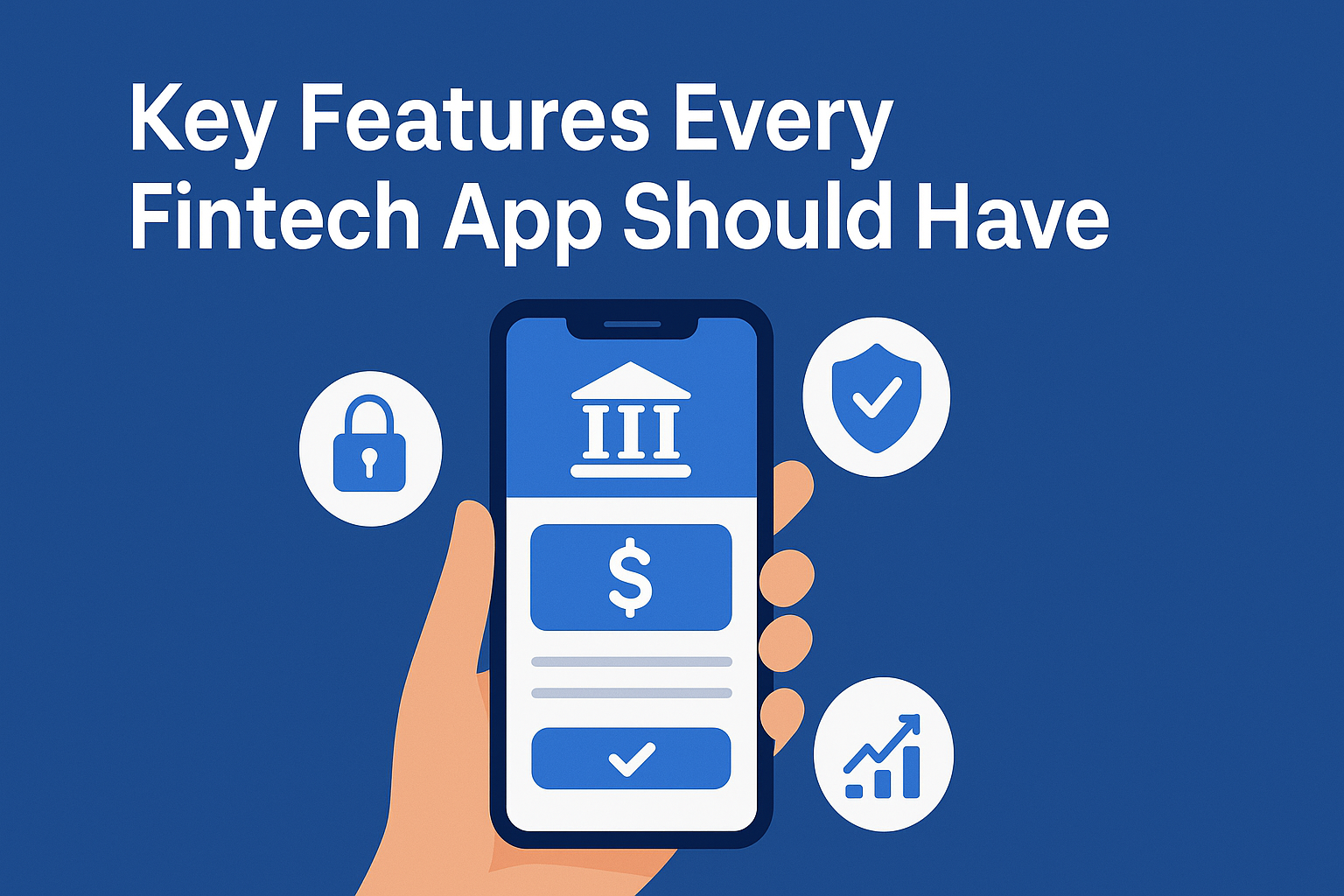Key Features Every Fintech App Should Have

Introduction
Financial technology, or fintech, has become one of the most disruptive forces across industries worldwide. From mobile banking and peer-to-peer payments to robo-advisory platforms and blockchain-powered transactions, fintech applications are redefining how people interact with money. Consumers now expect fast, secure, and intuitive financial solutions, and businesses are racing to deliver apps that meet these expectations.
But building a successful fintech app requires more than just an attractive interface. It involves embedding the right features that ensure security, efficiency, compliance, and user satisfaction. This article explores the key features every fintech app should have, highlighting what sets great applications apart in today’s digital-first economy.
1. User-Friendly Onboarding
The first interaction users have with any fintech app is onboarding. A smooth, intuitive onboarding process increases adoption rates and reduces drop-offs. Instead of lengthy forms, apps should offer guided sign-up flows, social logins, and biometric verification to simplify the process.
Personalization also plays a role here—apps can use data to tailor onboarding experiences, showing relevant features to users based on their financial goals. The goal is to minimize friction while maintaining necessary security checks.
2. Robust Security Features
Security is the backbone of any financial application. Since fintech apps deal with sensitive financial data, users must trust that their information is protected. Essential security features include:
-
Biometric authentication (fingerprint or facial recognition).
-
Multi-factor authentication (MFA) for secure access.
-
End-to-end encryption to safeguard transactions.
-
Fraud detection algorithms powered by machine learning.
By building a foundation of strong security, fintech apps not only comply with regulations but also strengthen user trust—critical for long-term adoption.
3. Seamless Payments Integration
One of the most sought-after features in fintech apps is seamless payment functionality. Users want to transfer funds, pay bills, and make purchases instantly, without unnecessary steps.
Integrating multiple payment methods—credit cards, debit cards, bank accounts, mobile wallets, and even cryptocurrencies—ensures users have the flexibility they expect. Real-time transaction tracking and instant notifications further enhance transparency.
For businesses that want flexibility in design and functionality, custom fintech app development provides a pathway to creating tailored solutions that can integrate unique payment flows while ensuring scalability.
4. Data Analytics & Spending Insights
Modern users are not just looking for a place to manage transactions—they want actionable insights. Fintech apps can use data analytics to provide users with spending breakdowns, financial health scores, and predictive recommendations.
For example, categorizing expenses into groups (food, travel, utilities, etc.) helps users understand where their money goes. Some apps even send alerts when spending habits deviate from set budgets. This type of financial intelligence fosters loyalty and positions the app as more than just a transactional tool.
5. Regulatory Compliance & KYC Integration
The financial industry is heavily regulated, and compliance is non-negotiable. A fintech app must integrate Know Your Customer (KYC) and Anti-Money Laundering (AML) processes to ensure legality and security.
Automated KYC tools, powered by AI and document recognition, reduce onboarding times while maintaining compliance standards. Beyond user verification, compliance features also include transaction monitoring and reporting systems to detect unusual activity.
Partnering with a trusted fintech software development company helps businesses navigate the complexities of global regulations, ensuring apps are compliant across multiple jurisdictions.
6. Personalization Through AI & Machine Learning
AI-driven personalization is becoming a hallmark of next-generation fintech apps. By analyzing transaction data and user behavior, apps can recommend financial products, investment opportunities, or even suggest ways to save money.
For instance, a fintech app might notice recurring subscription charges and suggest consolidating them or canceling unused services. Personalized dashboards, reminders, and product recommendations make the app indispensable in users’ daily financial lives.
7. Digital Wallets and Contactless Payments
The rise of digital wallets and contactless payments has transformed consumer behavior. Users now expect their fintech apps to support QR code payments, NFC-based transactions, and peer-to-peer transfers.
Offering an integrated wallet not only adds convenience but also creates opportunities for cross-selling and loyalty programs. The success of apps like Apple Pay, PayPal, and Google Wallet underscores the growing demand for this feature.
8. Cross-Platform Accessibility
Today’s users want consistent access across multiple devices. Whether they’re on a smartphone, tablet, or desktop, fintech apps should deliver a unified experience. Progressive Web Apps (PWAs) and cloud integration can help achieve this goal.
Cross-platform accessibility also ensures greater inclusivity, reaching users who prefer different operating systems or devices. Businesses that plan to scale globally must prioritize this feature to remain competitive.
9. Integration with Third-Party Services
Modern fintech ecosystems thrive on interoperability. Apps should be able to integrate with banking APIs, accounting software, investment platforms, and even e-commerce solutions.
For example, small business owners might want their fintech app to sync with invoicing tools, while individual users may seek integration with budgeting apps. Offering flexible APIs enables developers to extend functionality without reinventing the wheel.
When combined with custom marketplace development solutions, fintech apps can expand into platforms where financial services are connected to other industries like retail, travel, or real estate, further enhancing value for users.
10. Customer Support & Chatbots
No fintech app is complete without reliable customer support. Users dealing with financial transactions often need immediate help when problems arise. AI-powered chatbots can provide 24/7 assistance for routine queries, while live agents handle more complex issues.
In-app chat, voice support, and even video consultations are becoming standard in high-quality fintech applications. Fast, efficient support not only resolves issues but also improves overall trust and customer satisfaction.
11. Scalability and Future-Readiness
The fintech industry evolves quickly, and apps must be built with scalability in mind. Cloud infrastructure, modular architecture, and microservices ensure that applications can handle growing user bases without sacrificing performance.
Future-readiness also involves adopting emerging technologies such as blockchain, decentralized finance (DeFi), and open banking. Apps that evolve with the industry will remain competitive for years to come.
Conclusion
Building a fintech app is not just about design or coding—it’s about creating a secure, user-centric, and compliant platform that delivers real financial value. From seamless payments and robust security to personalization and regulatory compliance, the features outlined above are essential for success in today’s fintech landscape.
As consumer expectations continue to rise, businesses that prioritize innovation, security, and usability will stand out. Whether you’re a startup or an established enterprise, investing in the right features ensures your fintech app meets user needs today while remaining adaptable for tomorrow’s trends.







